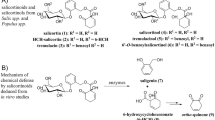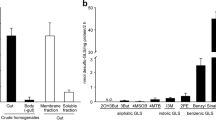Abstract
There are two different pathways known to be used for the detoxification of hydrocyanic acid in insects, viz., rhodanese and β-cyano-l-ala-nine synthase. We consider the latter to be indicative for cyanogenesis, while rhodanese might, in general, play a more important role in sulfur transfer for protein synthesis. This paper reports on the distribution of β-cyano-l-alanine (BCA) in the Lepidoptera. First reports of cyanogenesis are presented for the following families: Papilionidae, Pieridae, Lycaenidae, Hesperiidae, Lymantriidae, Arctiidae, Notodontidae, Megalopygidae, Limacodidae, Cymatophoridae, Noctuidae, Geometridae, and Yponomeutidae. New and old records for three other families, the Nymphalidae, Zygaenidae, and Heterogynidae, are included to complete the present state of knowledge. Special emphasis has been laid on the Nymphalidae, where BCA has been detected in eight subfamilies. Taxonomic, geographic, and seasonal variation has been found in a number of cases. In all cases observed so far, the source of cyanogenesis in the Lepidoptera is most probably the cyanoglucosides linamarin and lotaustralin, although cyanogenesis based on mustard oil glucosides and cyclopentenoid glucosides might occur as well. BCA has been found in both cryptic and aposematic species, including taxa such as the Pieridae, Danainae, Ithomiinae, and Arctiidae, where the defensive biology is believed to be linked with other compounds, like mustard oil glucosides, cardenolides, or pyrrolizidine alkaloids. The ecological interaction and significance of such secondary compounds is not yet understood.
Similar content being viewed by others
References
Beesley, S.G., Compton, S.G., andJones, D.A. 1985. Rhodanese in insects.J. Chem. Ecol. 11:45–50.
Blum, M.S., Jones, T.H., House, G.J., andTschinkel, W.R. 1981. Defensive secretions of tiger beetles: Cyanogenic basis.Comp. Biochem. Physiol. 69B:903–904.
Boppré, M. 1986. Insects pharmacophagously utilizing defensive plant chemicals (pyrrolizidine alkaloids).Naturwissenschaften 73:17–26.
Brattsten, L.B., Samuelian, J.H., Long, K.Y., Kincaid, S.A., andEvans, C.K. 1983. Cyanide as a feeding stimulant for the southern armyworm,Spodoptera eridiana.Ecol. Entomol. 8:125–132.
Brock, J.P. 1971. A contribution towards an understanding of the morphology and phytogeny of the ditrysian Lepidoptera.J. Nat. Hist. 5:29–102.
Brower, L.P., McEvoY, P.B., Williamson, K.L., andFlannery, M.A. 1972. Variation in cardiac glycoside content of monarch butterflies from natural populations in eastern North America.Science 10:426–429.
Brower, L.P., Gibson, D.O., Mottit, C.M., andPanchen, A.L. 1978. Cardenolide content ofDanaus chrysippus butterflies from three areas of East Africa.Biol. J. Linn. Soc. 10:251–273.
Conn, E.E. 1979. Biosynthesis of cyanogenic glucosides.Naturwissenschaften 66:28–34.
Conn, E.E. 1981a. Biosynthesis of cyanogenic glycosides, pp. 183–196,in B. Vennesland, E.E. Conn, C. Knowles, J. Westley, and F. Wissing. (eds.), Cyanide in Biology. Academic Press, London.
Conn, E.E. 1981b. Cyanogenic glycosides,in P.K. Stumpf and E.E. Conn (eds.). The Biochemistry of Plants. A Comprehensive Treatise, Vol. 7, Secondary Plant Products. Academic Press, New York.
Davis, R.H., andNahrstedt, A. 1979. Linamarin and lotaustralin as the source of Cyanide inZygaena filipendulae L. (Lepidoptera).Comp. Biochem. Physiol. 64B:395–397.
Davis, R.H., andNahrstedt, A. 1982. Occurrence and variation of the cyanogenic glucosides linamarin and lotaustralin in species of the Zygaenidae (Insecta: Lepidoptera).Comp. Biochem. Physiol. 71B:329–332.
Davis, R.H. andNahrstedt, A. 1984. Cyanogenesis in insects, pp. 635–654,in G.A. Kerkut and L.I. Gilbert (eds.). Comprehensive Insect Physiology, Biochemistry and Pharmacology, Vol. 11, Pharmacology. Pergamon Press, Oxford.
Duffey, S.S. 1981. Cyanide in arthropods, pp. 385–414,in B. Vennesland, E.E. Conn, C. Knowles, J. Westley, and F. Wissing, (eds.). Cyanide in Biology. Academic Press, London.
Franzl, S., andNaumann, C.M. 1984. Morphologie und Histologie der Wehrsekretbehälter erwachsener Raupen vonZygaena trifolii (Lepidoptera, Zygaenidae).Entomol. Abh. St. Mus. Tierk. Dresden 48:1–12.
Franzl, S., andNaumann, C.M. 1985. Cuticular cavities: Storage chambers for cyanoglucoside-containing defensive secretions in larvae of a zygaenid moth.Tissue Cell 17:267–278.
Hegnauer, R. 1962–1973. Chemotaxonomie der Pflanzen, Vols. I-VI. Birkhäuser, Basel.
Henrickson, H.R., andConn, E.E. 1969. Cyanide metabolism in higher plants.J. Biol. Chem. 244:2632–2640.
Jones, D.A. 1979. Chemical defense: Primary or secondary function.Am. Nat. 113:445–451.
Jones, D.A., Parson, J., andRothschild, M. 1962. Release of hydrocyanic acid from crushed tissues of all stages in the life cycle of species of the Zygaeninae (Lepidoptera).Nature 193:52–53.
Long, K.Y., andBrattsten, L.B. 1982. Is rhodanese important in the detoxification of cyanide in the armyworm (Spodoptera eridiana Cramer) larvae?Insect Biochem. 12:367–375.
Moore, B.P. 1967. Hydrogen cyanide in the defensive secretions of larval Paropsini (Coleoptera: Chrysomelidae).J. Aust. Entomol. Soc. 6:36–38.
Muhtasib, H., andEvans, D.L. 1987. Linamarin and histamine in the defensive of adultZygaena filipendulae.J. Chem. Ecol. 13:133–142.
Nahrstedt, A., andDavis, R.H. 1981. The occurrence of the cyanoglucosides linamarin and lotaustralin inAcraea andHeliconius butterflies.Comp. Biochem. Physiol. 68B:575–577.
Nahrstedt, A., andDavis, R.H. 1983. Occurrence, variation and biosynthesis of the cyanogenic glucosides linamarin and lotaustralin in species of the Heliconiini (Insecta, Lepidoptera).Comp. Biochem. Physiol. 75B:65–73.
Nahrstedt, A., andDavis, R.H. 1986. (R)Mandelonitrile and prunasin, the sources of hydrogen cyanide in all stages ofParopsis atomaria (Coleoptera, Chrysomelidae).Z. Naturforsch. 41C:928–934.
Naumann, C.M. 1985. Phylogenetische Systematik und klassisctypologische Systematik—mit einigen Anmerkungen zu stammesgeschichtlichen Fragen bei den Zygaenidae (Lepidoptera).Mitt. Muench. Entomol. Ges. 74:1–35.
Parsons, J., andRothschild, M. 1962. Rhodanese in the blow-fly,Calliphora vomitoria, L.J. Insect. Physiol. 8:285–286.
Parsons, J., andRothschild, M. 1964. Rhodanese in the larva and pupa of the common blue butterfly (Polyommatus icarus Rott.) (Lepidoptera).Entomol. Gaz. 15:58–59.
Povolny, M., andWeyda, F. 1981. On the glandular character of larval integument in the genusZygaena (Lepidoptera, Zygaenidae).Acta Entomol. Bohemoslov, 78:273–279.
Rothschild, M. 1985. British aposematic Lepidoptera, pp. 8–62,in J. Heath and A.M. Emmet (eds.), The moths and butterflies of Great Britain and Ireland. Harley Books, Martins/Essex.
Stahl, E., andKaltenbach, U. 1961. Dünnschicht-Chromatographie. VI. Mitteilung: Spurenanalyse von Zuckergemischen auf Kieselgel G-Schichten.J. Chromatogr. 5:351–355.
Volini, M., andAlexander, K. 1981. Multiple forms and multiple functions of the rhodaneses, pp. 77–91,in B. Vennesland, E.E. Conn, C. Knowles, J. Westley, and F. Wissing. (eds.). Cyanide in Biology. Academic Press, London.
Witthohn, K., andNaumann, C.M. 1984a. Qualitative and quantitative studies on the compounds ofZygaena trifolii (Esper, 1783) (Insecta, Lepidoptera, Zygaenidae).Comp. Biochem. Physiol. 79C:103–106.
Witthohn, K., andNaumann, C.M. 1984b. Die Verbreitung des β-Cyan-l-alanin bei cyanogenen Lepidopteren.Z. Naturforsch. 39c:837–840.
Wray, V., Davis, R.H., andNahrstedt, A. 1983. Biosynthesis of cyanogenic glucosides in butterflies and moths; incorporation of valine and isoleucine into linamarin and lotaustralin byZygaena andHeliconius species (Lepidoptera).Z. Naturforsch. 38c:583–588.
Author information
Authors and Affiliations
Rights and permissions
About this article
Cite this article
Witthohn, K., Naumann, C.M. Cyanogenesis—a general phenomenon in the lepidoptera?. J Chem Ecol 13, 1789–1809 (1987). https://doi.org/10.1007/BF01013229
Received:
Accepted:
Issue Date:
DOI: https://doi.org/10.1007/BF01013229




